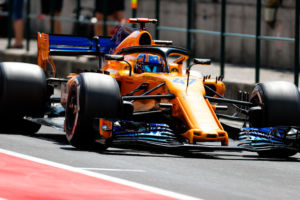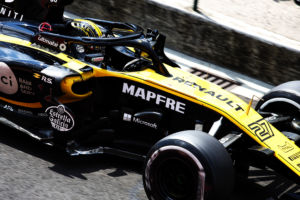2018 is the debut season in F1, and in junior series F2, of the frontal head protection system more commonly known as the halo. Despite its unpopularity, the device has already proven its worth on numerous occasions.
Back when the halo was still in development, one of the crashes looked at was that of the 2012 Belgian Grand Prix, when Romain Grosjean sent his car flying over Fernando Alonso’s, only narrowly missing the latter’s head. Grosjean was handed a race ban for the incident while everyone knew that Alonso had been very lucky to avoid any injury.

This time it’s another first lap crash at Spa involving Alonso that has caused debate surrounding the halo, and one that could’ve had a much different outcome had the device not been there. Nico Hulkenberg missed his braking point by quite some way, later saying that the turbulent air from the cars in front took weight off the front of his car, and ploughed into the back of Alonso. The Spaniard, now a passenger, then hit the back of Charles Leclerc’s car and was launched over the top of the Sauber, coming into contact with its halo.
As in 2012, all drivers involved walked away from the incident unscathed, and thoughts quickly turned to what sort of penalty Hulkenberg should get. It turned out to be a 10-place grid penalty for Monza, though Alonso insists that the penalty should’ve been more like that given to Grosjean in 2012.
The sheer damage to Leclerc’s halo was only realised when images of the device were released during the race. Alonso’s car, and more specifically his tyre, had left black rubber marks all over the right side of the halo, along with the side of the Sauber. Clearly, the outcome could, and would, have been a lot worse if those tyre marks were on Leclerc’s helmet and not his halo, showing exactly why the protection device was introduced.
Another thing the crash perfectly demonstrated is why the FIA were unwilling to delay the halo’s introduction. Imagine if that crash had happened and the halo wasn’t there. The outcome would have been a lot worse, while the FIA would be open to numerous lawsuits and we might just have lost one of F1’s brightest young stars.
This crash is, however, not the first one in 2018 to prove the halo’s worth. When Tadasuke Makino and Nirei Fukuzumi came together earlier in the F2 season, Fukuzumi’s tyre ended up on Makino’s halo, leaving similar black marks to those left on Leclerc’s. This should have ended the halo debate there and then, with Makino saying that the halo “saved his life”, but still it rumbled on.
Haters of the halo are, on various social media platforms, still trying to find ways to complain about it, despite both Leclerc and Makino’s crashes. I’ve seen a lot say that the wheel wouldn’t have come into contact with either of their heads anyway, so the halo doesn’t need to be there. But, there’s no proof for that, either way. Surely, it’s better to err on the side of caution by having the halo there, rather than risk it with their head’s exposed.
The presence of the halo makes championships without it look very exposed and excessively dangerous by comparison. Take IndyCar, for example. At Pocono, there was a huge wreck in which Robert Wickens’ car came perilously close to Ryan Hunter-Reay’s head, and a piece of debris entered James Hinchcliffe’s cockpit causing damage to his hands. Just watching IndyCar, Pocono aside, it looks like their heads are so exposed, something that has only really come to light because of the halo.

The FIA have said that they’ll share their findings from Leclerc’s crash with IndyCar, but the latter is unable to use the halo due to visibility issues on ovals and super-speedways. Nevertheless, the American series is looking to introduce a windscreen-type solution for next season.
Fellow drivers have praised the halo after Leclerc’s crash, with Leclerc himself saying that he was glad to have it over his head. 2016 world champion Nico Rosberg declared that the halo discussion was over because it clearly can save lives while Felipe Massa said that it can now be called “beautiful”. There has been a huge outcry of support for the halo and a crash like this, however awful it is to say, was needed to prove to the doubters that the device effective. Now there can be no question about that.
The strongly-opinionated type will probably still criticise the halo but, the fact is, it’s the best solution to the problem that currently exists. Eventually, there will be a halo replacement or adaptation that is better-looking but, in the meantime, the halo is most definitely here to stay and whether you like it or not, expect other series to be adopting it very soon.
Featured image – Alfa Romeo Sauber F1 Team

